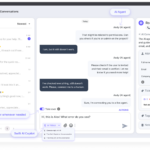Your IT support team is what keeps technology workflows running smoothly in the background for all of your other company’s employees. An important component of this is the help desk, which acts as the interface that workers use to submit requests and the hub for support team technicians to process them. Whether you’re setting up an entirely new system or migrating to using other help desk software, there are several key aspects that successful help desks are built on.
Smart Issue Handling
Arguably the core feature of any good help desk is the issue support tracking system, also called a IT ticketing system. This allows submitted issues to be saved as tickets for the support team’s reference. Tickets then act as documentation on the issue, including issue priority, who reported it, the agents assigned to it and its resolution status. These tickets can be organized for easy reference at any point.
Ideally, issue tracking should be automated and integrated with all possible channels of contact, including phone calls, email and live chat services. On the support team’s side, this ensures no tickets get lost by directing them all to a single point.
Even after an issue is resolved, tickets are still useful. As support agents work towards a resolution, they can document the process to illustrate what works and what doesn’t for later reference. Additionally, tickets can be reopened if need be. This creates a continuity that establishes accountability and aids in resolving similar issues in the future.
Internal Knowledge Management
Since support technicians each possess their own knowledge and experience, it’s vital that others can access relevant knowledge when needed without relying on the most experienced agent to be there. That agent may be preoccupied with another matter, for instance, or they may eventually leave the company. Additionally, newly-hired technicians need to be brought up to speed on the particular systems that the business relies on. To this end, knowledge bases provide a way to make technical knowledge, instruction manuals, troubleshooting guides and more accessible.
A knowledge base contains a library of content, with each article assigned a unique identifier and various attributes for indexing and categorization, and one or more tools for locating relevant content. Here, information on using and maintaining the company’s systems can be stored for reference, whether for support agents or for other employees. Integrating with your issue tracking system aids in collecting information on past issues, which can be used to create a “frequently asked questions” page or even automated “canned” responses to common issues, alleviating the workload that agents face.
Self-Service for Common Issues
The help desk system should not only facilitate reporting and handling issues but also allow issues to be resolved more quickly. One major aspect of this is with issue tracking, but equally important is to minimize time spent on common, simple issues so that support agents can focus efforts on higher priority tasks. A self-service portal is an interface through which users can find the answers they need on their own.
Linking a self-service portal to your help desk’s knowledge base gives employees the ability to perform their own troubleshooting by checking answers to FAQs, consulting with chatbots on routine matters or looking up instructional guides. Besides freeing up support agents’ time, this also lets users receive help at any time without being dependent on waiting for a live agent’s response.
User Feedback
To tie everything together and allow your help desk to continue performing effectively in the future, user feedback is a critical tool. Tracking metrics like response and resolution times, as well as surveying users on how they feel the help desk handled issues, provides insight on where agents and the help desk system can improve. Take advantage of the tools that are already consolidating information on issues and responses to make reports and identify trends.
Improvement applies not only to the machine-based aspects of the help desk but also the agents and how they approach users and questions—the human element is what makes your business run.

































